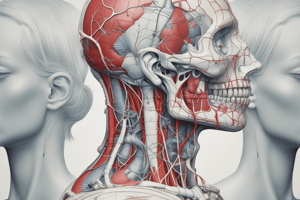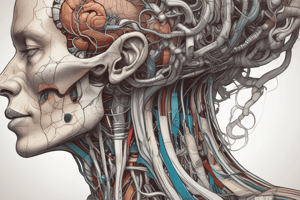Podcast
Questions and Answers
Which part of the human body is notably associated with dental relevance?
Which part of the human body is notably associated with dental relevance?
- Palatine region (correct)
- Inferior vena cava
- Superior palpebra
- Dee muscle
Which of the following is NOT a part of the oral cavity?
Which of the following is NOT a part of the oral cavity?
- Inferior palatine
- Superior palatine
- Tonsillar region
- Dee region (correct)
What is indicated as unnecessary to memorize verbatim, according to the information provided?
What is indicated as unnecessary to memorize verbatim, according to the information provided?
- Relational terms
- All terms and structures (correct)
- Anatomical structures
- Dental terminologies
Which structure is involved in speech and often noted in discussions around dental relevance?
Which structure is involved in speech and often noted in discussions around dental relevance?
The structure referred to as the 'plica sublingualis' is primarily associated with which area?
The structure referred to as the 'plica sublingualis' is primarily associated with which area?
Which of the following does NOT have a direct connection to dental anatomy?
Which of the following does NOT have a direct connection to dental anatomy?
Which structure is the final drainage point for venous blood from the head and neck?
Which structure is the final drainage point for venous blood from the head and neck?
What is a significant feature of the pterygoid plexus?
What is a significant feature of the pterygoid plexus?
Which of the following is NOT a factor that contributes to effective learning in anatomy?
Which of the following is NOT a factor that contributes to effective learning in anatomy?
What process describes how venous drainage from the head moves?
What process describes how venous drainage from the head moves?
Which area is primarily drained by the tributaries into the superior vena cava?
Which area is primarily drained by the tributaries into the superior vena cava?
Why is it important for dental professionals to know the venous drainage of the head and neck?
Why is it important for dental professionals to know the venous drainage of the head and neck?
Which statement correctly describes the flow of venous blood returning from the head?
Which statement correctly describes the flow of venous blood returning from the head?
What is one of the primary reasons for knowing the location of important vessels in the head and neck?
What is one of the primary reasons for knowing the location of important vessels in the head and neck?
Which major vein drains blood from the cervical region into the superior vena cava?
Which major vein drains blood from the cervical region into the superior vena cava?
Which vein is formed by the confluence of multiple superficial submandibular veins?
Which vein is formed by the confluence of multiple superficial submandibular veins?
What is the primary function of the posterior auricular vein?
What is the primary function of the posterior auricular vein?
What major vein does the internal jugular vein join?
What major vein does the internal jugular vein join?
Which veins are primarily responsible for draining the muscles of the neck?
Which veins are primarily responsible for draining the muscles of the neck?
What does the internal jugular vein drain?
What does the internal jugular vein drain?
Which of the following veins serves as a tributary to the internal jugular vein?
Which of the following veins serves as a tributary to the internal jugular vein?
Which statement accurately describes the external jugular vein?
Which statement accurately describes the external jugular vein?
Which vein is involved in draining the skin from areas around the ear?
Which vein is involved in draining the skin from areas around the ear?
Which vein primarily drains the blood from the anterior aspect of the neck?
Which vein primarily drains the blood from the anterior aspect of the neck?
What is the primary function of the vertebral veins?
What is the primary function of the vertebral veins?
Which veins each have external counterparts to the internal jugular vein?
Which veins each have external counterparts to the internal jugular vein?
From where do the internal and external jugular veins drain blood?
From where do the internal and external jugular veins drain blood?
The posterior external jugular vein forms from the union of which veins?
The posterior external jugular vein forms from the union of which veins?
Which vein among the following is responsible for draining blood from the upper body into the superior vena cava?
Which vein among the following is responsible for draining blood from the upper body into the superior vena cava?
What area does the external jugular vein primarily drain?
What area does the external jugular vein primarily drain?
Which vein does not have an external counterpart?
Which vein does not have an external counterpart?
What is the role of the superior vena cava regarding jugular veins?
What is the role of the superior vena cava regarding jugular veins?
Which of the following pairs includes two types of jugular veins?
Which of the following pairs includes two types of jugular veins?
Which structure does NOT drain into the external jugular vein?
Which structure does NOT drain into the external jugular vein?
Which veins drain into the left brachiocephalic vein?
Which veins drain into the left brachiocephalic vein?
Which of the following correctly describes the symmetry of the brachiocephalic veins?
Which of the following correctly describes the symmetry of the brachiocephalic veins?
What is the primary tributary of the right brachiocephalic vein?
What is the primary tributary of the right brachiocephalic vein?
Which structure receives blood from the brachiocephalic veins?
Which structure receives blood from the brachiocephalic veins?
What anatomical feature is shared by the right and left brachiocephalic veins?
What anatomical feature is shared by the right and left brachiocephalic veins?
Regarding the tributaries of the left brachiocephalic vein, which statement is inaccurate?
Regarding the tributaries of the left brachiocephalic vein, which statement is inaccurate?
Which of the following pairs of veins is primarily responsible for draining into the superior vena cava?
Which of the following pairs of veins is primarily responsible for draining into the superior vena cava?
What is a correct statement about the left and right subclavian veins?
What is a correct statement about the left and right subclavian veins?
In the context of venous drainage, what function do the brachiocephalic veins serve?
In the context of venous drainage, what function do the brachiocephalic veins serve?
To which large vein do the brachiocephalic veins ultimately contribute their flow?
To which large vein do the brachiocephalic veins ultimately contribute their flow?
Flashcards
Palatine region
Palatine region
The Palatine region is the roof of the mouth, an area relevant to dentistry due to its proximity to teeth and gums.
Dee region
Dee region
The Dee region is not a recognized part of the oral cavity.
Memorizing All Terms
Memorizing All Terms
Memorizing all anatomical terms and structures verbatim is not crucial, focus on understanding their functions and relationships.
Lingual Frenulum
Lingual Frenulum
Signup and view all the flashcards
Plica sublingualis
Plica sublingualis
Signup and view all the flashcards
Brachial Plexus
Brachial Plexus
Signup and view all the flashcards
Superior vena cava
Superior vena cava
Signup and view all the flashcards
Pterygoid Plexus
Pterygoid Plexus
Signup and view all the flashcards
Only Textbooks
Only Textbooks
Signup and view all the flashcards
Head Venous Drainage
Head Venous Drainage
Signup and view all the flashcards
Superior vena cava Tributaries
Superior vena cava Tributaries
Signup and view all the flashcards
Venous Drainage in Dentistry
Venous Drainage in Dentistry
Signup and view all the flashcards
Venous Blood Flow
Venous Blood Flow
Signup and view all the flashcards
Vessel Location
Vessel Location
Signup and view all the flashcards
Internal Jugular Vein
Internal Jugular Vein
Signup and view all the flashcards
Anterior Jugular Vein
Anterior Jugular Vein
Signup and view all the flashcards
Posterior Auricular Vein
Posterior Auricular Vein
Signup and view all the flashcards
Internal Jugular and Subclavian Vein
Internal Jugular and Subclavian Vein
Signup and view all the flashcards
Cervical and Suprascapular Veins
Cervical and Suprascapular Veins
Signup and view all the flashcards
Internal Jugular Vein Drainage
Internal Jugular Vein Drainage
Signup and view all the flashcards
Pharyngeal Venous Plexus
Pharyngeal Venous Plexus
Signup and view all the flashcards
External Jugular Vein
External Jugular Vein
Signup and view all the flashcards
Posterior Auricular Vein
Posterior Auricular Vein
Signup and view all the flashcards
Anterior Jugular Vein
Anterior Jugular Vein
Signup and view all the flashcards
Vertebral Veins
Vertebral Veins
Signup and view all the flashcards
External Vertebral Veins
External Vertebral Veins
Signup and view all the flashcards
Jugular Vein Drainage
Jugular Vein Drainage
Signup and view all the flashcards
Posterior external jugular vein
Posterior external jugular vein
Signup and view all the flashcards
Internal Jugular Vein
Internal Jugular Vein
Signup and view all the flashcards
External Jugular Vein
External Jugular Vein
Signup and view all the flashcards
Brachiocephalic Vein
Brachiocephalic Vein
Signup and view all the flashcards
Superior vena cava
Superior vena cava
Signup and view all the flashcards
Internal and External Jugular Veins
Internal and External Jugular Veins
Signup and view all the flashcards
External Jugular Vein Drainage
External Jugular Vein Drainage
Signup and view all the flashcards
Left Brachiocephalic Vein Tributaries
Left Brachiocephalic Vein Tributaries
Signup and view all the flashcards
Brachiocephalic Vein Symmetry
Brachiocephalic Vein Symmetry
Signup and view all the flashcards
Right Brachiocephalic Vein Tributary
Right Brachiocephalic Vein Tributary
Signup and view all the flashcards
Superior vena cava
Superior vena cava
Signup and view all the flashcards
Brachiocephalic Vein Function
Brachiocephalic Vein Function
Signup and view all the flashcards
Left Brachiocephalic Vein Tributaries
Left Brachiocephalic Vein Tributaries
Signup and view all the flashcards
Internal Jugular Veins
Internal Jugular Veins
Signup and view all the flashcards
Subclavian Veins
Subclavian Veins
Signup and view all the flashcards
Brachiocephalic Vein Function
Brachiocephalic Vein Function
Signup and view all the flashcards
Brachiocephalic Vein Flow
Brachiocephalic Vein Flow
Signup and view all the flashcards
Study Notes
Venous Drainage of the Head and Neck
- Venous drainage starts from the head and neck and moves downwards, eventually reaching the superior vena cava.
- The superior vena cava drains into the right atrium of the heart.
- The main tributaries draining into the superior vena cava are the right and left brachiocephalic veins.
- The right and left brachiocephalic veins receive blood from the right and left internal jugular veins, right and left subclavian veins, and the right and left vertebral veins.
- The internal jugular veins receive blood from the brain, skull, oral cavity, and superficial structures of the face and neck.
- The external jugular vein has multiple branches that drain areas in the face and neck.
- The posterior external jugular vein forms from the confluence of the posterior retromandibular vein and the posterior auricular vein.
- The posterior auricular vein drains the skin from behind the ear.
- The cervical and suprascapular veins drain the muscles of the neck.
- The anterior jugular vein is formed by the confluence of multiple superficial submandibular veins and drains blood from the anterior aspect of the neck.
- The internal jugular vein also has many tributaries draining areas in the face and neck.
- It is not essential to know all of these tributaries; however, dental practitioners should be aware of those with clinical relevance, including the inferior petrosal sinus, veins of the cochlear duct, meningeal veins, pharyngeal venous plexus, and the palatine, pterygoid, facial, and lingual veins.
Studying That Suits You
Use AI to generate personalized quizzes and flashcards to suit your learning preferences.
Related Documents
Description
This quiz covers the venous drainage system of the head and neck, detailing the pathway from various veins to the superior vena cava. It includes the roles of the internal and external jugular veins, brachiocephalic veins, and other tributaries in draining blood from the brain, face, and neck. Test your knowledge of this essential anatomical system!




